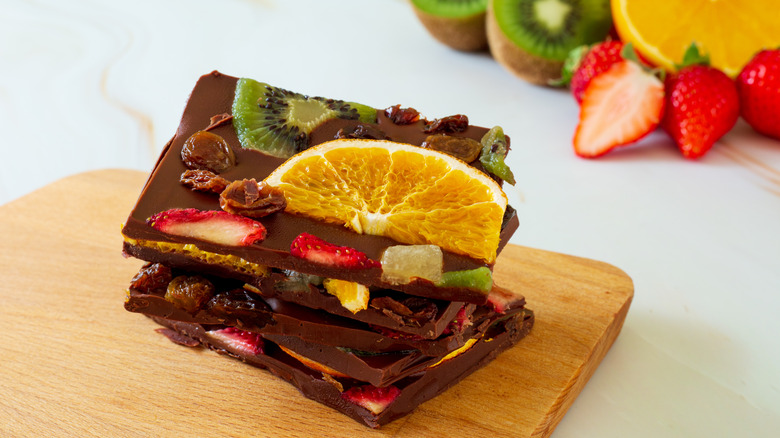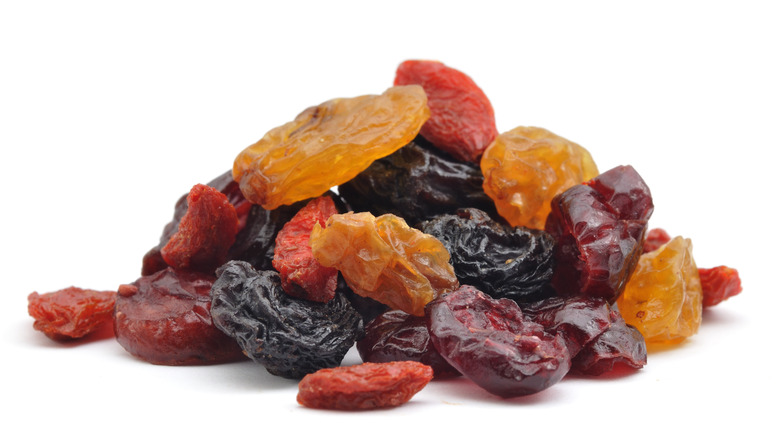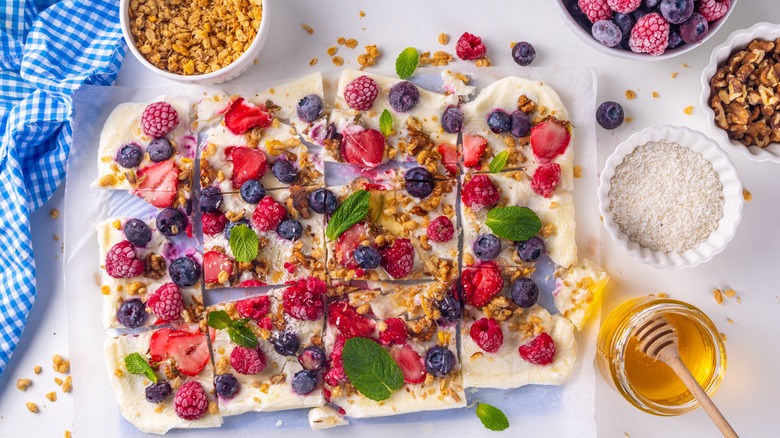Add Dried Fruit To Chocolate Bark For A Lovely Tart Bite
Whether you like it as an ice cream flavor or melted into your favorite candy bar, chocolate is an intercultural delicacy that is enjoyed from Brooklyn to Bangkok and beyond. Aside from its inherently luxurious flavor, one of our favorite things about chocolate is how customizable and adaptable it is. When it comes to chocolate, if you can dream it up, you can probably make it. Enter chocolate bark – the easy-to-make and versatile confectionery made by melting chocolate, spreading it into a thin layer, and then adding various toppings before allowing it to cool and harden. The result? A sumptuous sheet of chocolate that can be broken into irregular pieces that resemble tree bark. Although this imaginative chocolate treat is great on its own, introducing dried fruit to your chocolate bark is an easy way to give it a little extra pizzazz.
Whether it is dark and semi-bitter or milky and rich, adding dry fruit to chocolate imbues this crunchy dessert with a balancing tartness complemented by gentle whispers of natural sweetness. Dehydrated fruit provides chocolate bark with a pleasant textural contrast between the firm, yet breakable quality of the bark and the luxurious chewiness of the fruit. It's not just the flavor and texture of chocolate bark that is improved by adding dried fruit to the mix, they can also add depth to the visual aesthetics of the dessert as the bright colorful fruits will stand out against the backdrop of the chocolate.
Dried fruit versus fresh fruit
Before you head to your local supermarket to pick up a pack of dehydrated fruit for your next spread of chocolate bark, consider the differences between fresh fruit and dehydrated fruit.
For starters, dehydrated fruits have a significantly longer shelf life compared to fresh fruits, which means that chocolate bark infused with dry fruit can be stored for an extended period without concerns about the freshness of the fruit components. Dried fruits have had their moisture content reduced through the dehydration process, which is advantageous in chocolate bark as it helps maintain the crisp texture of the bark without introducing excess moisture that fresh fruits might bring. Dehydration also concentrates the flavors of fruits, intensifying their natural sweetness and bringing a pungent fruity flavor to your chocolate bark.
When it comes to nutrition, don't worry about diminishing the nourishing spirit of fruit by using dehydrated fruit in place of fresh fruit. Dried fruit is just as nutritious as fresh fruit and contains over three times more fiber by weight than its juicier counterpart.
Fruity flavor combinations
To get the most out of your dried fruit-kissed chocolate bark, you'll need some fun, funky, and fresh flavor combinations that will leave your tastebuds singing.
Combine dehydrated pineapple, mango, acai, and toasted coconut flakes for a tropical take on a chocolatey treat that's further complemented by a generous drizzle of coconut cream. Create a tart, berry-licious chocolate bark that balances the rich sweetness of the chocolate with the zesty essence of dried strawberries, blueberries, raspberries, and crushed pistachios for a touch of nutty crunchiness. Blend dehydrated apple slices with apricots, raisins, and a dash of cinnamon for a springy, orchard-inspired chocolate bark that evokes the atmosphere of a fresh fruit harvest. If you want a caramel-inspired bark without going to the trouble of actually making it, dehydrated dates can take on the sugary spirit of caramel and a touch of jagged sea salt can bring out its cozy flavors. If you're bored of dark chocolate, enjoy the comforts of rich, creamy white chocolate whose luxurious flavor is perfectly offset by the tartness of dried fruit.
Whichever way you choose to make your chocolate bark, as long as you're incorporating dried fruit, you'll be on cloud nine in no time.


